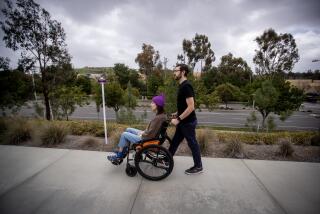Op-Ed: We’re starting to understand long COVID. Next we can fight it

- Share via
We’ve been chasing the coronavirus since the pandemic began with vaccines and drugs, never getting ahead of it. In fact, well into its third year, COVID-19 is still causing often disabling symptoms among many people who were infected in early 2020.
The condition of long COVID, also known as post-acute sequelae of SARS CoV-2 infection, is rife with mysteries. While its incidence among adults who have been infected has been estimated at 5% to 40%, a recent study that tracked symptoms before infections and compared participants to controls has given us one of the best snapshots to date. It indicated that 1 in 8 people who have had COVID experience prolonged symptoms over many months.
With vaccinations and different variants, the incidence may be lower, but even if it were half as many (6% of adults who have been infected), and we assume two-thirds of adults have had COVID, that would equate to more than 10 million Americans who have endured persistent symptoms that interfere with their daily life activities, frequently impairing their ability to return to work.
One of the mysteries: As opposed to those most likely to get severe COVID, the vast majority of people affected by long COVID are younger (30 to 50 years old) and previously healthy. The typical symptoms include marked fatigue, exercise intolerance, difficulty breathing, brain fog, muscle pain and weakness, chest pain, headaches and fast heart rate. While the list of troubling symptoms is long, the number of proven therapies is very short — zero.
The first step for identifying candidate therapies is to demystify the biology of long COVID. A better understanding of its basis has come from recent studies that zoom in on an immune response that has gone haywire. That can include antibodies attacking the body’s own proteins; persistent antibodies to the virus’ spike protein, indicating a reservoir of infection triggering a response; exhausted T-cells; and markers of reactivation of prior virus infections in the herpes virus family (Epstein-Barr and varicella-zoster).
A combined team from Yale and Mount Sinai used artificial intelligence to determine what, of so many factors, may be of central importance in determining whether a COVID patient develops lingering symptoms. There was a singular driver — low cortisol in the blood — a particularly intriguing finding.
This hormone, produced by the adrenal gland in response to stress, has diverse functions. When it is below healthy levels, as has also been found in chronic fatigue syndrome, it could be tied to some of the symptoms of long COVID. Normally a dip in cortisol would trigger the brain to tell the pituitary gland to increase its output of adrenocorticotropic hormone. However, in the new report, ACTH levels were quite low, indicating that the problem is not at the adrenal gland, but localized to the brain. Perhaps that helps explain why preliminary studies of giving steroids to people with long COVID have not shown any benefit. The steroids have aimed to address symptoms in the body instead of root causes in the brain.
Some people with long COVID have a marked increase in heart rate and lightheadedness (and near fainting) when standing from a reclining position. This is thought to stem from dysfunction of the autonomic nervous system and raises the possibility that inflammation of the nervous system, in or outside the brain, might be a unifying underpinning of long COVID.
While these studies have helped illuminate potential biomarkers, we still do not have one that has been validated in large numbers of people with long COVID, which is essential to provide an objective measure. Large studies will also be needed to determine effectiveness of treatments inspired by these findings.
We are very late in the process of doing randomized clinical trials to find a treatment that relieves symptoms or provides full resolution. There are more than 25 trials that have been launched with many different types of drugs or supplements, but all of them are quite small. The trials have generally not been partitioned by the cluster of patient symptoms, such as those with lightheadedness or people who are predominantly suffering from difficulty breathing and brain fog. With so many millions of people impaired, the need for accelerating clinical trials with promising immune-system modulating or virus-inactivating agents is beyond urgent.
The “long” in long COVID has not been emphasized enough. A new report from more than 1.25 million people with COVID showed an increased risk of developing brain fog, dementia, seizures and psychosis over two years. Similarly, follow-up at one year or longer has shown an increased risk of heart and blood vessel diseases, diabetes, clotting disorders, and lung and kidney damage, even among people who had only mild to moderate COVID and were not hospitalized. Such risk appears to be cumulatively increased with reinfections, including infections that break through vaccinations.
While we await a validated biomarker and effective treatments, what can we do about long COVID? First off, we can drop the skepticism and denial. Long COVID is real, and it takes a real toll. In the latest study, which followed patients and controls for an average of 400 days, there is a very close tracking of self-reported symptoms with objective markers — in fact 94%.
The recent relaxation of mitigation measures by the Centers for Disease Control and Prevention is premature, at a time when COVID hospitalizations are at a plateau for adults at more than 40,000, four times what they were in April, and still rising for children. Fortunately, children are at very low risk for long COVID, but the rare cases are linked with a doubling of some serious sequelae such as cardiovascular events.
For all ages, vaccination and booster rates in the U.S. are very low, even though it has been shown that vaccination helps minimize the chance of developing long COVID. Right now, our best chance to prevent long COVID is to not get COVID or to avoid getting it again. That’s why it’s vital to stay COVID-cautious now, and not capitulate to the notion that we should “live with COVID.”
Too many people are indeed living with chronic COVID, detracting from their daily lives. As we eventually emerge from this pandemic, long COVID will be the enduring, major public health complication that we failed to address in a timely and aggressive manner. It’s not too late to invest in understanding and combating it.
Eric J. Topol is a professor of molecular medicine at Scripps Research and author of the newsletter Ground Truths.
More to Read
A cure for the common opinion
Get thought-provoking perspectives with our weekly newsletter.
You may occasionally receive promotional content from the Los Angeles Times.









